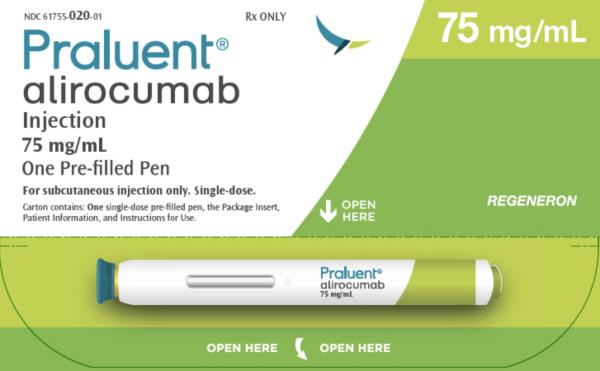Praluent Side Effects
Generic name: alirocumab
Note: This document contains side effect information about alirocumab. Some dosage forms listed on this page may not apply to the brand name Praluent.
Applies to alirocumab: subcutaneous solution.
Serious side effects of Praluent
Along with its needed effects, alirocumab (the active ingredient contained in Praluent) may cause some unwanted effects. Although not all of these side effects may occur, if they do occur they may need medical attention.
Check with your doctor immediately if any of the following side effects occur while taking alirocumab:
More common
- Chest pain or tightness
- difficulty with breathing or swallowing
- fast heartbeat
- fever
- hives, itching, skin rash
- hoarseness
- irritation
- joint pain, stiffness, or swelling
- nausea
- reddening of the skin, especially around the ears
- swelling of eyelids, face, lips, hands, or feet
- unusual tiredness or weakness
Less common
- Cough producing mucus
Incidence not known
- Large, hive-like swelling on the face, eyelids, lips, tongue, throat, hands, legs, feet, sex organs
Other side effects of Praluent
Some side effects of alirocumab may occur that usually do not need medical attention. These side effects may go away during treatment as your body adjusts to the medicine. Also, your health care professional may be able to tell you about ways to prevent or reduce some of these side effects.
Check with your health care professional if any of the following side effects continue or are bothersome or if you have any questions about them:
More common
- Bleeding, blistering, burning, coldness, discoloration of the skin, feeling of pressure, hives, infection, inflammation, itching, lumps, numbness, pain, rash, redness, scarring, soreness, stinging, swelling, tenderness, tingling, ulceration, or warmth at the injection site
- chills
- cough
- diarrhea
- general feeling of discomfort or illness
- headache
- loss of appetite
- muscle aches, cramps, stiffness, or pains
- shivering
- sore throat
- stuffy or runny nose
- sweating
- trouble sleeping
- vomiting
Less common
- Bladder pain
- bloody or cloudy urine
- bone pain
- bruise
- difficult, burning, or painful urination
- difficulty with moving
- frequent urge to urinate
- lower back or side pain
- muscle spasms
- pain or tenderness around the eyes and cheekbones
For Healthcare Professionals
Applies to alirocumab: subcutaneous solution.
General
The most commonly reported adverse reactions have included nasopharyngitis, injection site reactions, and influenza.[Ref]
Hypersensitivity
Common (1% to 10%): Hypersensitivity reaction, nummular eczema, hypersensitivity vasculitis
Postmarketing reports: Angioedema[Ref]
Respiratory
Very common (10% or more): Nasopharyngitis (11.3%)
Common (1% to 10%): Influenza, bronchitis, sinusitis, cough[Ref]
Gastrointestinal
Common (1% to 10%): Diarrhea[Ref]
Genitourinary
Common (1% to 10%): Urinary tract infection[Ref]
Hepatic
Common (1% to 10%): Elevated liver enzymes[Ref]
During clinical trials, 2.5% of patients treated with this drug reported abnormal liver enzymes (placebo=1.8%); treatment discontinuation occurred in 0.4% and 0.2% of patients receiving this drug and placebo, respectively. Increases in serum transaminases to greater than 3 times the upper limit of normal occurred in 1.7% of patients treated with this drug (placebo=1.4%).[Ref]
Immunologic
Common (1% to 10%): Development of antidrug antibody (ADA), neutralizing antibodies (NAb)
Postmarketing reports: Flu-like illness[Ref]
Local
Common (1% to 10%): Injection site reaction (erythema, redness, itching, swelling, pain, tenderness)[Ref]
Patients who developed ADA (antidrug antibody) had a higher incidence of injection site reactions compared with patients who did not develop ADA (10.2% vs 5.9%).[Ref]
Musculoskeletal
Common (1% to 10%): Myalgia, muscle spasm, contusion, musculoskeletal pain[Ref]
Nervous system
Uncommon (0.1% to 1%): Neurocognitive events, confusion or memory impairment[Ref]
Metabolic
Frequency not reported: Low LDL-C values
During clinical trials with both every 2 week or every 4 week dosing, reports of 2 consecutive calculated LDL-C values less than 25 mg/dL, and less than 15 mg/dL were reported in 914 and 335 patients, respectively. Low LDL-C values were observed more frequently in patients treated with 150 mg every 2 weeks or 400 mg every 4 weeks. Changes to background lipid therapy was not made and adverse consequences were not identified, but the long-term effects of very low levels of LDL-C are not known.
Frequently asked questions
- Praluent vs Repatha: What's the difference?
- What are PCSK9 Inhibitors and how do they work?
- How does Praluent work?
- Does it lower triglycerides?
- How do you administer the injection?
More about Praluent (alirocumab)
- Check interactions
- Compare alternatives
- Pricing & coupons
- Reviews (283)
- Drug images
- Dosage information
- Patient tips
- During pregnancy
- FDA approval history
- Drug class: PCSK9 inhibitors
- Breastfeeding
- En español
Patient resources
Professional resources
Related treatment guides
References
1. Product Information. Praluent Pen (alirocumab). sanofi-aventis. 2015.
Further information
Always consult your healthcare provider to ensure the information displayed on this page applies to your personal circumstances.
Some side effects may not be reported. You may report them to the FDA.

